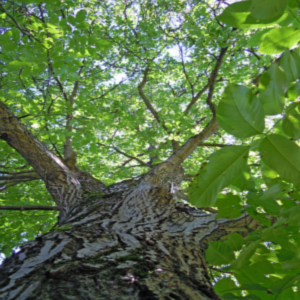Fun Facts Regarding Black Walnut Wood

One of my favorite hardwoods is black walnut. Its primary native region is the Midwest and east-central United States. It was a common tree to find in the woods as a boy growing up in Illinois. It is easily identified by its unique leaves and bark. The leaves are compound and alternately arranged on the stem and 1–2 ft long. The leaves are overall dark green in color and are typically hairy on the underside. The bark is typically grey-black and deeply furrowed into thin ridges that provides a unique diamond shaped pattern.
The fruit is highly prized by wildlife and humans. It ripens during the autumn. The fruit is a nut with a brownish-green, semi-fleshy husk and a brown, corrugated nut. The whole fruit, including the husk falls in October or November; the seed is relatively small and very hard. I can remember my dad cracking the nuts when I was a child so mom would have walnuts for Christmas baking. The husk of the fruit is allelopathic. This is simply a big word that means it excretes chemicals into its environment that hurt or hinder herbaceous competition.
Black walnut is known for its beautiful and unique dark-brownish heartwood. However, it is always important to learn to identify wood species based on their unique anatomical features rather than color. This is because color can vary but the anatomical structure will not. For example, the sun can “bleach” the color from a walnut board.
The wood is heavy, strong, shock resistant and yet can be easily split and worked. The dark color of the heartwood is due to a high concentration of organic phenolic compounds known as “extractives.” These compounds can be extracted from the wood using different solutions – hot water, acetone, caustic soda, etc. The extractives also give the heartwood a natural decay resistance, so it is somewhat resistant to wood destroying insects and fungi. The wood can be kiln dried and holds its shape well after seasoning, which makes it ideal for wood working. Walnut wood has historically been used for veneer, gun stocks, furniture, flooring, coffins, etc. It is a highly prized species and unfortunately is often subject to timber theft.
Many years ago, I was asked to help Southern University in Baton Rouge, La purchase some lumber to repair a mock court room for their law students. They wanted me to identify the wood species of the existing wood which would help them to purchase replacement boards. Most people thought the wood was black walnut and at first glance it certainly looked like it. However, after a microscopic examination it was evident that this was not black walnut. The wood was butternut. Both of these woods are from the same genus but are a different species. One key difference is that butternut does not have crystals in the longitudinal parenchyma, but they occur sporadically in black walnut. Butternut is also lower in density, but I was unable to remove any boards to determine density so all I had to go on was to take some small slivers of the wood and study the cell structure under a microscope. I have been fooled before by the naked eye, but the microscope is always right.
Meet the Author
Dr. Todd Shupe is the President of Wood Science Consulting, LLC. He is a well-recognized expert on wood forensics, wood preservation, wood decay and degradation, and wood species identification. He has a broad background in new product development, quality management, and marketing and sales in both the public and private sectors. For more information please visit DrToddShupe.com.
We welcome your comments below.
Thank you for visiting. We trust that you have enjoyed reading our articles.
Liked this post? Read more below or search for more topics . . .

